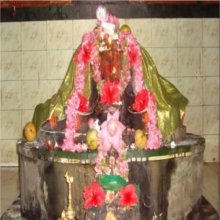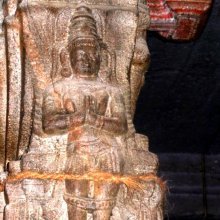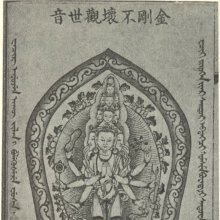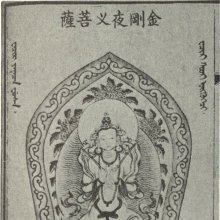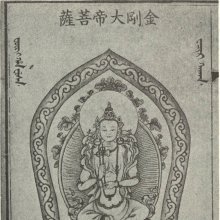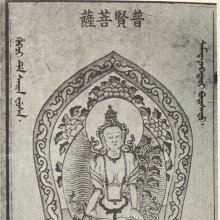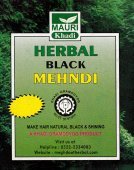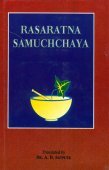Thi, Thī: 6 definitions
Introduction:
Thi means something in Hinduism, Sanskrit, Buddhism, Pali, Marathi, Jainism, Prakrit. If you want to know the exact meaning, history, etymology or English translation of this term then check out the descriptions on this page. Add your comment or reference to a book if you want to contribute to this summary article.
Images (photo gallery)
(+3446 more images available)
Languages of India and abroad
Pali-English dictionary
Source: BuddhaSasana: Concise Pali-English Dictionarythī : (f.) a woman.
Source: Sutta: The Pali Text Society's Pali-English DictionaryThī, (f.) (Vedic strī, on which see Walde, Lat. Wtb. under sero. This form thī is the normal correspondent to Vedic strī; the other, more usual (& dial.) form is itthi) a woman J. I, 295, 300; V, 296 (thī-pura), 397; VI, 238. (Page 309)

Pali is the language of the Tipiṭaka, which is the sacred canon of Theravāda Buddhism and contains much of the Buddha’s speech. Closeley related to Sanskrit, both languages are used interchangeably between religions.
Marathi-English dictionary
Source: DDSA: The Molesworth Marathi and English Dictionaryṭhī (ठी).—f The place (in reading, narrating, writing) at which one had arrived when some interruption caused him to break off. 2 An appointed or usual spot or moment. 3 Art, way, process, proper method or management. ṭhīsa ṭhī miḷaṇēṃ (From a little story of some raw poet.) To agree, coincide, correspond; to fall together genially.
Source: DDSA: The Aryabhusan school dictionary, Marathi-Englishṭhī (ठी).—or
--- OR ---
thī (थी).—o-
Marathi is an Indo-European language having over 70 million native speakers people in (predominantly) Maharashtra India. Marathi, like many other Indo-Aryan languages, evolved from early forms of Prakrit, which itself is a subset of Sanskrit, one of the most ancient languages of the world.
Prakrit-English dictionary
Source: DDSA: Paia-sadda-mahannavo; a comprehensive Prakrit Hindi dictionaryThī (थी) in the Prakrit language is related to the Sanskrit word: Strī.
Prakrit is an ancient language closely associated with both Pali and Sanskrit. Jain literature is often composed in this language or sub-dialects, such as the Agamas and their commentaries which are written in Ardhamagadhi and Maharashtri Prakrit. The earliest extant texts can be dated to as early as the 4th century BCE although core portions might be older.
Sanskrit dictionary
Source: DDSA: Paia-sadda-mahannavo; a comprehensive Prakrit Hindi dictionary (S)Thī (थी) in the Sanskrit language is related to the Prakrit words: Vīhi, Vīhiyā, Vīhī.
Sanskrit, also spelled संस्कृतम् (saṃskṛtam), is an ancient language of India commonly seen as the grandmother of the Indo-European language family (even English!). Closely allied with Prakrit and Pali, Sanskrit is more exhaustive in both grammar and terms and has the most extensive collection of literature in the world, greatly surpassing its sister-languages Greek and Latin.
See also (Relevant definitions)
Starts with (+1980): Thi be, Thi-dak-dak-araung, Thia, Thia thia, Thiaanthii, Thiabuli, Thialbal, Thialkha, Thiallawn, Thialret, Thiam, Thiam mae haang, Thian baan, Thian daeng, Thian dok, Thian khaao, Thian king, Thian suan, Thian taak, Thian thai.
Ends with (+4010): A-campirannatacamati, A-karpaviputi, Abahatthi, Abhimanthi, Abhitosthi, Abhivutthi, Abhyarthi, Acaikkilatti, Acammati, Acanaveti, Acankati, Acanti, Acarati, Acaravitthi, Acariyamutthi, Acarpirati, Acaruti, Acaryashashthi, Acatti, Accalatti.
Full-text (+55504): Manmathin, Vinayapramathin, Avyathin, Pramathin, Pathin, Ihaloka, Rathin, Vailati, Pitayuthi, Artharthin, Avalakati, Ratarthin, Suvarnayuthi, Svarnayuthi, Kashthamathi, Ashvaratha, Tarkupithi, Apakararthin, Avikatha, Bhagirathi.
Relevant text
Search found 574 books and stories containing Thi, Thī, Ṭhī; (plurals include: This, Thīs, Ṭhīs). You can also click to the full overview containing English textual excerpts. Below are direct links for the most relevant articles:
Patthana Dhamma (by Htoo Naing)
Chapter 24 - Vippayutta paccayo (or dissociation condition)
Chapter 8 - Anantara paccayo (or proximity condition)
Folk Tales of Gujarat (and Jhaverchand Meghani) (by Vandana P. Soni)
Chapter 20 - Nir Jal Mas < [Part 3 - Kankavati]
Chapter 35 - Vikram and Khapro < [Part 5 - Rang Chee Barot]
Maha Kassapa (by Hellmuth Hecker)
Dhyana in the Buddhist Literature (by Truong Thi Thuy La)
2.2: (1c) The Four Jhānas and Their Development < [Chapter 2 - The Dhyāna as depicted in Hinayāna Literature]
2.3: (a) The Four Foundations of Mindfulness (introduction) < [Chapter 2 - The Dhyāna as depicted in Hinayāna Literature]
The history of Andhra country (1000 AD - 1500 AD) (by Yashoda Devi)
Part 9 - Keta III and Ganapati (A.D. 1234-1240) < [Chapter V - The Kotas (A.D. 1100-1270)]
Part 15 - Choda II (A.D. 1350) < [Chapter II - The Haihayas]
Rig Veda (translation and commentary) (by H. H. Wilson)
Related products
(+498 more products available)
